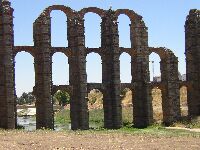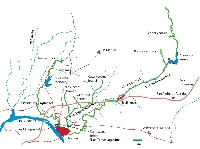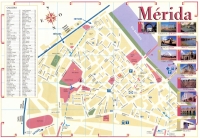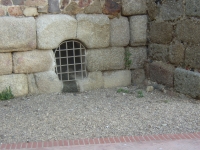
| For the photo's, see below |
| Home / the complete website |
In the year 25 BC Emerita Augusta became a colony and a century later it had three major aqueducts two of which started with a dam in the upper parts of rivers.
Cornalvo aqueduct
The Cornalvo aqueduct is the oldest and about 17km long. The aqueduct was originally built without the dam, and
did not get its water from springs but was rather fed by a number of small branches that drained sediments of the
Albarregas river. The dam was built later, around the time of the Proserpina dam described below, and it is not
even certain which parts are roman and which parts may be later additions. The dam is 194m long, 20m
high and on top 8m broad with a few flights of stairs at the water side. The Cornalvo dam is an earthern dam
covered with masonry, and has a unique separate water inlet tower 10m from the dam at the inside.
Just downstream from the dam is a side branche of the aqueduct, the Borbollón branch which also drains
its water from an aquifer in sedements. A feeder aqueduct taps a small brook called Las Muellas N of Cornalco and
brings additional water to the reservoir.
The water channel of the Cornalvo aqueduct runs mostly in tunnels, without major bridges and enters the town
on the east side. A few remnants of the aqueduct are still visible in the town.
Las Tomas aqueduct(also known as Rabo de Buey)
Proserpina aqueduct
The Proserpina aquaduct is based at a dam which is located about 10 km north of Merida.
It is the youngest of the three aqueducts of Merida and was build in the time of Traian at
the beginning of the first century AD. A feeder aqueduct brings additional water into the
reservoir of the dam, which collects the water from the Proserpina aqueduct.
The dam is 427m long, 21,6m high and at the crest 2,3m wide. It is a earthen dam supported
on the inside by a 6m thick retaining wall. This wall is built from a concrete core and
granite masonry facing. The dam is built from three segments of slightly different orientation.
On the inside nine buttresses support the retaining wall of the dam when the water is
drained from the reservoir; without these buttresses, the retaining wall would collapse
due to the pressure of the wet earth in the dam embarkment behind it. It has been suggested
that is was the collapse of another similar dam, that of Alcantarilla for the aqueduct
of Toledo, which brought the Roman engineers to build this safety feature into their design.
On the outside, there are also buttresses, 16 in total, supporting the retaining wall, but
these are covered by the earth embarkment and only known from drilling.
Two inlet towers are situated on the inside of the retaining wall. One contains two lead
pipes of 22cm diametre placed three meters above the base of the dam, and the other inlet
pipe higher up in the tower, where the water could be let out of the dam into the aqueduct.
The water was transported to Merida trough an aqueduct 10km in length which entered the
north side of the town by means of an aqueduct bridge over the river Rio Albarregas.
The bridge has a maximum height of 30 meters with a span of nearly 4,5m. The pillars
have dimensions of 3 x 3 m (10 roman feet = 2,96m). Because of its impressive appearance
the bridge is called Los Milagros (the miracles). A number of storks nest on the tops
of the ruined pillars of the Milagros aqueduct and make it more impressive still.
The modest ruins of the castellum divisorium can be visited in a street some hundreds of
metres south of the bridge; this is the end of the Proserpina aqueduct.
| Item | Cornalvo | Las Tomas | Proserpina |
|---|---|---|---|
| Length | 17 km | ? km | 12 km |
| Cross-section | x m | x m | x m |
| Volume | ..000 m3/day | ..000 m3/day | ..000 m3/day |
| Gradient | ..% | ..% | ..% |
| Period | 1 century AD | ?? century | 2 century AD |
| Features |
|
|
|
| Recommended literature : | K. Grewe: Augusta Emerita / Mérida - eine Stadt römischer Technikgeschichte (Antike Welt (1993) p244) |
| Recommended website : | Traianus site |
| How to visit : | see maps and the descriptions at the individual aqueducts |
| HOME | More literature on more aqueducts | Last modified: March 25, 2005 - Wilke D. Schram (w.d.schram 'at' romanaqueducts.info) |

Overview |

Townplan |

Outlet of the cloaca |